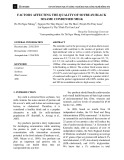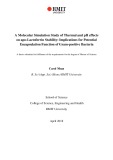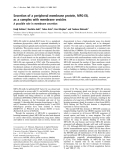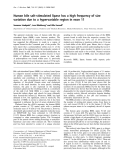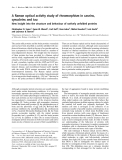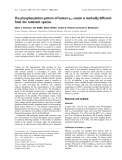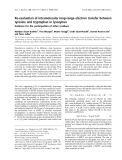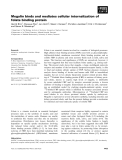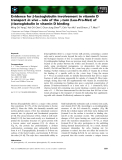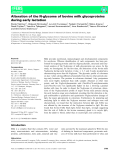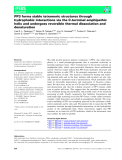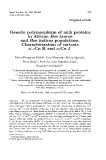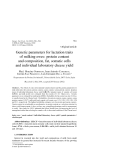
Milk protein
-
Soy milk is extracted from soybeans. Soy milk contains the same amount of protein and fat as cow’s milk, and it does not contain sugar, lactose, or cholesterol. In this study, we investigated the blend ratio of soybeans: black sesame was 8/2; 7/3; 6/4; 5/5; 4/6; milk to sugar was 8/2; 7/3; 6/4; 5/5; 4/6; and milk is assimilation level 500bar, 1000bar, 1500bar.
 7p
7p  viyamanaka
viyamanaka
 06-02-2025
06-02-2025
 4
4
 2
2
 Download
Download
-
This study has adopted a systematic approach to identify the extent to which 20 kHz ultrasound affects the particle size and solubility of different protein solutions containing 4%, 7% and 10% whey proteins, caseins or a mixture at a range of energy densities (15-400 J/mL) and various pH (4.0-9.0). Milk proteins hold a prominent place in the food industry as they are used in many manufactured products for their functionality and most importantly nutritional benefits.
 136p
136p  runthenight04
runthenight04
 02-02-2023
02-02-2023
 8
8
 2
2
 Download
Download
-
In this Masters thesis computational modelling techniques were employed to investigate iron-free apo-Lactoferrin (apo-Lf) structural conformation changes in the presence of variant temperature and pH. These conditions represent the environment most milk protein goes through in food processing and the production of food products.
 162p
162p  runthenight04
runthenight04
 02-02-2023
02-02-2023
 9
9
 3
3
 Download
Download
-
The present work reports isolation and characterization of a highly glycosylated protein from bovine milk fat globule membranes, known as PAS III. Partial amino-acid sequencing of the purified protein allowed construction of degenerate oligonucleotide primers, enabling isolation of a full-length cDNA encoding a protein of 330 amino-acid residues. N-terminal amino-acid sequencing of derived peptides and the purified protein confirmed 76% of the sequence and demonstrated presence of a cleavable signal peptide of 23 residues, leaving a mature protein of 307 amino acids.
 9p
9p  system191
system191
 01-06-2013
01-06-2013
 50
50
 4
4
 Download
Download
-
MFG-E8 (milk fat globule-EGF factor 8) is a peripheral membrane glycoprotein, which is expressed abundantly in lactating mammary glands and is secreted in association with fat globules. This protein consists of two-repeated EGF-like domains, a mucin-like domain and two-repeated discoidinlike domains (C-domains), and contains an integrin-binding motif (RGD sequence) in the EGF-like domain. To clarify the role of each domain on the peripheral association with the cell membrane, several domain-deletion mutants of MFG-E8 were expressed in COS-7 cells. ...
 10p
10p  research12
research12
 01-06-2013
01-06-2013
 58
58
 3
3
 Download
Download
-
The apparent molecular mass of human milk bile salt-stimulated lipase (BSSL) varies between mothers. The molecular basis for this is unknown, but indirect evidence has suggested the dierences to reside in a region of repeats located in the C-terminal part of the protein. We here report that a polymorphism within exon 11 of the BSSLgene is the explanation for the molecular variants of BSSL found in milk.
 9p
9p  research12
research12
 01-06-2013
01-06-2013
 47
47
 4
4
 Download
Download
-
The casein milk proteins and the brain proteinsa-synuclein and tau have been described as natively unfolded with ran-domcoil structures,which, inthecaseofa-synucleinandtau, have a propensity to form the ®brils found in a number of neurodegenerative diseases. New insight into the structures of these proteins has been provided by a Raman optical activity study, supplemented with dierential scanning cal-orimetry, of bovineb-andj-casein, recombinant humana-, b-andc-synuclein,
 9p
9p  research12
research12
 29-04-2013
29-04-2013
 44
44
 4
4
 Download
Download
-
Caseins are highly phosphorylated milk proteins assembled in large colloidal structures termed micelles. In the milk of ruminants, as1-casein has been shown to be extensively phosphorylated. In this report we have determined the phosphorylation pattern of humanas1 -casein by a combi-nationofmatrix-assisted laserdesorptionmass spectrometry and amino acid sequence analysis. Three phosphorylation variants were identified. A nonphosphorylated form, a variant phosphorylated at Ser18 and a variant phosphory-lated at Ser18 and Ser26.
 5p
5p  tumor12
tumor12
 20-04-2013
20-04-2013
 35
35
 4
4
 Download
Download
-
One-electron oxidation of six different c-type lysozymes from hen egg white, turkey egg white, human milk, horse milk, camel stomach and tortoise was studied by gamma-and pulse-radiolysis.In the first step, one tryptophan side chain is oxidized to indolyl free radical, which is produced quantitatively.As shown already, the indolyl radical subse-quently oxidizes a tyrosine side chain to the phenoxy radical in an intramolecular reaction.However this reaction is not total and its stoichiometry depends on the protein.Rate constants also vary between proteins, from 120Æs )1 to 1000Æs )1 at pH 7.
 7p
7p  tumor12
tumor12
 20-04-2013
20-04-2013
 43
43
 2
2
 Download
Download
-
The intracellular role of placental protein 17b (PP17b)/ TIP47has been controversial, because it is considered tobe a protein required for mannose 6-phosphate receptor trans-port from endosome totrans-Golgi as well as a neutral lipid droplet-associatedprotein.The similaritybetween theamino acid sequences of PP17 variants, adipophilin and perilipins, andbetween their gene structures indicate that PP17baswell as other alternatively spliced PP17 variants belong to the lipid storage droplet protein family, containing also some differentiation factors....
 13p
13p  tumor12
tumor12
 20-04-2013
20-04-2013
 40
40
 3
3
 Download
Download
-
Folate is an essential vitamin involved in a number of biological processes. High affinity folate binding proteins (FBPs) exist both as glycosylphospha-tidylinositol-linked, membrane associated folate binding proteins and as soluble FBPs in plasma and some secretory fluids such as milk, saliva and semen. The function and significance of FBPs are unresolved, however, it has been suggested that they may facilitate folate uptake, e.g. during suck-ling.
 8p
8p  fptmusic
fptmusic
 11-04-2013
11-04-2013
 43
43
 2
2
 Download
Download
-
b-lactoglobulin (LG) is a major bovine milk protein, containing a central calyx and a second exosite beyond the calyx to bind vitamin D; however, the biological function of LG in transporting vitamin D remains elusive. Crystallographic findings from our previous study showed the exosite to be located at the pocket between the a-helix and b-strand I.
 15p
15p  viettel02
viettel02
 22-02-2013
22-02-2013
 26
26
 2
2
 Download
Download
-
Milk provides nutritional, immunological and developmental components for newborns. Whereas identification of such components has been per-formed by targeting proteins and free oligosaccharides, structural and func-tional analyses of the N-glycome of milk glycoproteins are scarce.
 13p
13p  cosis54
cosis54
 09-12-2012
09-12-2012
 46
46
 2
2
 Download
Download
-
The milk protein proteose peptone component 3 (PP3), also called lacto-phorin, is a small phosphoglycoprotein that is expressed exclusively in lactating mammary tissue. The C-terminal part of the protein contains an amphipathic helix, which, upon proteolytic liberation, shows antibacterial activity. Previous studies indicate that PP3 forms multimeric structures and inhibits lipolysis in milk.
 12p
12p  cosis54
cosis54
 08-12-2012
08-12-2012
 41
41
 2
2
 Download
Download
-
Tuyển tập các báo cáo nghiên cứu về sinh học được đăng trên tạp chí sinh học thế giới đề tài: Genetic polymorphism of milk proteins in African Bos taurus and Bos indicus populations
 0p
0p  toshiba19
toshiba19
 15-11-2011
15-11-2011
 59
59
 3
3
 Download
Download
-
Tuyển tập các báo cáo nghiên cứu về sinh học được đăng trên tạp chí sinh học thế giới đề tài: Genetic parameters for lactation traits of milking ewes: protein content and composition, fat, somatic cells and individual laboratory cheese yield
 16p
16p  toshiba19
toshiba19
 08-11-2011
08-11-2011
 54
54
 5
5
 Download
Download
CHỦ ĐỀ BẠN MUỐN TÌM








